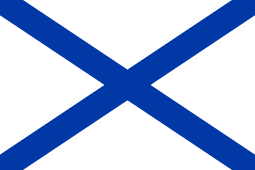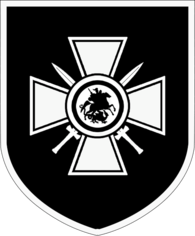Russian collaborationism with the Axis powers
Unprecedented numbers of Soviet citizens collaborated with the Axis powers during World War II. They were both ethnically Russian and non-Russian. It is estimated that the number of Soviet collaborators with the Nazi German military was between one and two and a half million.
Background

The two main forms of mass collaboration in the Nazi-occupied territories of the Soviet Union throughout World War II were both military in nature. It is estimated that anywhere between 600,000 and 1,400,000 Soviets (Russians and non-Russians) joined the Wehrmacht forces as Hiwis (or Hilfswillige) in the initial stages of the German Operation Barbarossa, ahead of the subsequent implementation of the more oppressive administrative methods by the SS. As much as 20% of the German manpower in Soviet Russia was composed of the former Soviet citizens. About half of them were ethnic Russians. The second type of mass collaboration were the indigenous security formations (majority non-ethnically Russian) running into hundreds of thousands and possibly as high as two million (250,000 volunteers in the East Legions alone). Military collaboration – wrote Alex Alexiev – took place in truly unprecedented numbers suggesting that, more often than not, the Germans were perceived at first as lesser of two evils.[1]
In the autumn of 1941, Field Marshal von Bock had sent to Hitler's Headquarters a detailed project for the organization of a Liberation Army of some 200,000 Russian volunteers, and for the formation of a local government in the province of Smolensk. It was returned in November 1941 with the notation that "such thoughts cannot be discussed with the Führer," and that "politics are not the prerogatives of Army Group Commanders." Of course, Field-Marshal Keitel, who wrote this notation, did not show the project to Hitler.[2]
Russian Liberation Movement
SS Sturmbrigade RONA

The SS Sturmbrigade RONA (Русская освободительная национальная армия, РОНА; in Latin, RONA), nicknamed the "Kaminski Brigade" after its commander, SS-Brigadefuhrer Bronislav Kaminski, was a collaborationist force originally formed out of a Nazi-led militia unit in the Lokot Autonomy, a small puppet regime set up by the Germans to see if a Russian puppet government would be reliable. Kaminski and the leader of the government, Konstantin Voskoboinik, killed by partisans in 1942, formed a unit that had a strength of 10,000—15,000. As the Red Army advanced, the Kaminski troops were forced to retreat into Belarus, and then into Poland in 1944. There, the RONA was reorganized into an SS brigade, with majority of their troops Russians, and the rest were of minorities, including Ukrainians, Belarusians, and some Azerbaijanis. In August, 1,700 brigade troops under Major Yuri Frolov were sent to Warsaw to quell an uprising. During it, the RONA troops became infamous for their atrocities, committing murder, rape, and theft. It was described that some soldiers left the combat zone with carts of stolen goods. About 400 soldiers were lost in combat, including Frolov.
At the end of August, Bronislav Kaminski was killed. His death was surrounded with mystery, as official records state that he was killed by Polish partisans, however, it is believed that Kaminski was executed by the SS. The reasons for it are thought to be his unit's war crimes and/or now that Heinrich Himmler supported the Russian Liberation Movement of General Vlasov, he wanted to eliminate a potential rival. The rest of the brigade was reformed into the 29th SS Waffen Grenadier Division "RONA", which was disbanded in November 1944. Its remaining 3,000–4,000 members were sent to join Vlasov's army.[3]

Russian volunteers in the German Air Force
The Russians who volunteered with the Luftwaffe were equipped with captured Soviet aircraft but also German biplanes including: Arado Ar 66C, Gotha Go 145C, Polikarpov U-2 VS(Po-2) and Yakovlev Yak UT-2 (AIR-20) among others for making nighttime land attacks against Red Army lines on the Eastern front. Their command headquarters were located in Minsk, Soviet Belarus.
- 1.Ostfl.St.(Russische) (Eastern volunteers Sqdn.) (Minsk)
- 1/NSGr.1 (Russische) (Kovno)
- 2/NSGr.1 (Russische) (Kovno)
- Stab I./Eins.Gr.Fl.Sch.Div. (Russische) (Borisov)
- Russisch Lehr Fl. Div. (Air Training operative Div). (Borisov)
- 2/Eins.Gr.Fl.Sch Div. (Russische) (Borisov)
- 3/Eins.Gr.Fl.Sch.Div. (Russische) (Borisov)
- 1/Eins.Gr.Fl.Sch.Div. (Russische) (Dubinskaya)
Newspapers
- Dobrovoletz (Der Freiwillige) – Russian volunteer units
- Novoye Slovo — Official political news of Andrei Vlasov, in Berlin
See also
- Collaboration with the Axis Powers during World War II
- Reichskommissariat Moskowien initially Reichskommissariat Russland
References
- ↑ Director of the Net Assessment, Office of the Secretary of Defense. "Soviet Nationalities in German Wartime Strategy, 1941–1945" (PDF file, direct download). MDA 903-80-C-0224. The Rand Publications Series. pp. vi, 26–27, 34. ISBN 0833004247. Retrieved 15 July 2014.
- ↑ Lt. Gen Wladyslaw Anders and Antonio Munoz. "Russian Volunteers in the German Wehrmacht in WWII". Feldgrau.com. Retrieved 15 July 2014.
Source: Wen Sie Verderben Wollen [Gebundene Ausgabe] by Jürgen Thorwald, pp. 82-83. ASIN: B0000BOL08.
- ↑ RONA Brigade, Warsaw Uprising
